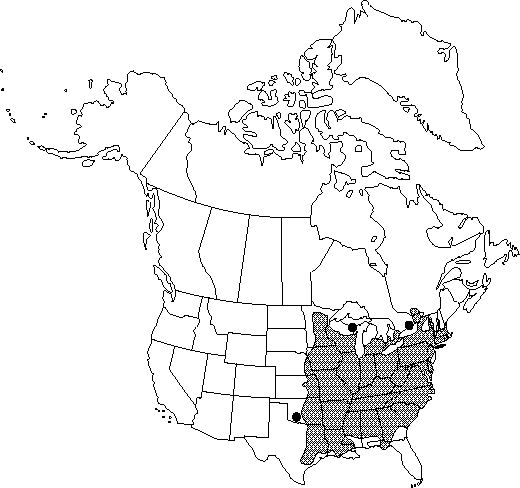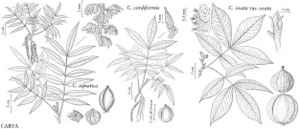Difference between revisions of "Carya cordiformis"
Dendrologie 1: 597. 1869.
FNA>Volume Importer |
imported>Volume Importer |
||
| (7 intermediate revisions by 2 users not shown) | |||
| Line 13: | Line 13: | ||
}}{{Treatment/ID/Special_status | }}{{Treatment/ID/Special_status | ||
|code=F | |code=F | ||
| − | |label= | + | |label=Illustrated |
}} | }} | ||
| − | |basionyms={{Treatment/ID/ | + | |basionyms={{Treatment/ID/Basionym |
|name=Juglans cordiformis | |name=Juglans cordiformis | ||
|authority=Wangenheim | |authority=Wangenheim | ||
| + | |rank=species | ||
| + | |publication_title=Beytr. Teut. Forstwiss., | ||
| + | |publication_place=25, plate 10, fig. 25. 1787 | ||
}} | }} | ||
|synonyms={{Treatment/ID/Synonym | |synonyms={{Treatment/ID/Synonym | ||
|name=Hicoria cordiformis | |name=Hicoria cordiformis | ||
|authority=(Wangenheim) Britton | |authority=(Wangenheim) Britton | ||
| − | }}{{Treatment/ID/Synonym | + | |rank=species |
| + | }} {{Treatment/ID/Synonym | ||
|name=Hicoria minima | |name=Hicoria minima | ||
|authority=(Marshall) Britton | |authority=(Marshall) Britton | ||
| + | |rank=species | ||
}} | }} | ||
|hierarchy=Juglandaceae;Carya;Carya cordiformis | |hierarchy=Juglandaceae;Carya;Carya cordiformis | ||
| Line 33: | Line 38: | ||
}}<!-- | }}<!-- | ||
| − | --><span class="statement" id="st- | + | --><span class="statement" id="st-undefined" data-properties=""><b>Trees,</b> to 52 m. <b>Bark</b> gray or brownish, smooth or ridged or exfoliating with small platelike scales. <b>Twigs</b> tan, slender, glabrous except scaly near tip. <b>Terminal</b> buds sulfur yellow to tan, oblong, 10(-19) mm, densely scaly with yellow peltate scales, pilose near apex; bud scales valvate; axillary buds protected by pair of valvate bracteoles. <b>Leaves</b> 2-4 dm; petiole 3-7 cm, glabrous near base, hirsute near rachis. <b>Leaflets</b> (5-)7-9(-13), lateral petiolules 0-1 mm, terminal petiolules 2-8 mm; blades ovate-lanceolate, rarely falcate, 3-19 × 1-7 cm, margins finely to coarsely serrate, without tufts of hairs, apex acuminate; surfaces abaxially villous with unicellular and 2-4-rayed fasciculate hairs along midrib and major veins, densely to sparsely pubescent throughout, and with abundant large peltate scales and small round and 2- or 4-lobed peltate scales in spring, still present near margins at base and apex in fall, adaxially villous along midrib near base, sparsely scaly in spring. <b>Staminate</b> catkins pedunculate, to 16 cm, stalks without hairs or hirsute, bracts scaly; anthers hirsute. <b>Fruits</b> brown, cylindric, obovoid, or nearly spheric, not compressed or only slightly compressed, 2-3 × 2-3.2 cm; husks rough, 2-3 mm thick, dehiscing to middle or slightly below, sutures winged; nuts light brown, ellipsoid to ovoid, not compressed or only slightly compressed, not angled, rugulose; shells thin. <b>Seeds</b> bitter. <b>2n</b> = 32.</span><!-- |
-->{{Treatment/Body | -->{{Treatment/Body | ||
| Line 40: | Line 45: | ||
|elevation=0-900 m | |elevation=0-900 m | ||
|distribution=Ont.;Que.;Ala.;Ark.;Conn.;Del.;D.C.;Fla.;Ga.;Ill.;Ind.;Iowa;Kans.;Ky.;La.;Maine;Md.;Mass.;Mich.;Minn.;Miss.;Mo.;Nebr.;N.H.;N.J.;N.Y.;N.C.;Ohio;Okla.;Pa.;R.I.;S.C.;Tenn.;Tex.;Vt.;Va.;W.Va.;Wis. | |distribution=Ont.;Que.;Ala.;Ark.;Conn.;Del.;D.C.;Fla.;Ga.;Ill.;Ind.;Iowa;Kans.;Ky.;La.;Maine;Md.;Mass.;Mich.;Minn.;Miss.;Mo.;Nebr.;N.H.;N.J.;N.Y.;N.C.;Ohio;Okla.;Pa.;R.I.;S.C.;Tenn.;Tex.;Vt.;Va.;W.Va.;Wis. | ||
| − | |discussion=<p>Carya cordiformis hybridizes with C. illinoinensis (C. ×brownii Sargent), C. ovata (C. ×laneyi Sargent), and C. laciniosa, and reputedly with the tetraploid C. glabra (C. ×demareei Palmer).</p><!-- | + | |discussion=<p><i>Carya cordiformis</i> hybridizes with <i>C. illinoinensis</i> (C. ×brownii Sargent), <i>C. ovata</i> (C. ×laneyi Sargent), and <i>C. laciniosa</i>, and reputedly with the tetraploid <i>C. glabra</i> (C. ×demareei Palmer).</p><!-- |
| − | --><p>The Fox Indians used Carya cordiformis medicinally as a diuretic, a laxative, and a panacea (D. E. Moerman 1986).</p> | + | --><p>The Fox Indians used <i>Carya cordiformis</i> medicinally as a diuretic, a laxative, and a panacea (D. E. Moerman 1986).</p> |
|tables= | |tables= | ||
|references= | |references= | ||
| Line 50: | Line 55: | ||
-->{{#Taxon: | -->{{#Taxon: | ||
name=Carya cordiformis | name=Carya cordiformis | ||
| − | |||
|authority=(Wangenheim) K. Koch | |authority=(Wangenheim) K. Koch | ||
|rank=species | |rank=species | ||
| Line 64: | Line 68: | ||
|publication title=Dendrologie | |publication title=Dendrologie | ||
|publication year=1869 | |publication year=1869 | ||
| − | |special status=Endemic; | + | |special status=Endemic;Illustrated |
| − | |source xml=https:// | + | |source xml=https://bitbucket.org/aafc-mbb/fna-data-curation/src/2e0870ddd59836b60bcf96646a41e87ea5a5943a/coarse_grained_fna_xml/V3/V3_427.xml |
|genus=Carya | |genus=Carya | ||
|species=Carya cordiformis | |species=Carya cordiformis | ||
| − | |||
| − | |||
| − | |||
| − | |||
| − | |||
| − | |||
| − | |||
| − | |||
| − | |||
| − | |||
| − | |||
| − | |||
| − | |||
| − | |||
| − | |||
| − | |||
| − | |||
| − | |||
| − | |||
| − | |||
| − | |||
| − | |||
| − | |||
| − | |||
| − | |||
| − | |||
| − | |||
| − | |||
| − | |||
| − | |||
| − | |||
| − | |||
| − | |||
| − | |||
| − | |||
| − | |||
| − | |||
| − | |||
| − | |||
| − | |||
| − | |||
| − | |||
| − | |||
| − | |||
| − | |||
| − | |||
| − | |||
| − | |||
| − | |||
| − | |||
| − | |||
| − | |||
| − | |||
| − | |||
| − | |||
| − | |||
| − | |||
| − | |||
| − | |||
| − | |||
| − | |||
| − | |||
}}<!-- | }}<!-- | ||
-->[[Category:Treatment]][[Category:Carya]] | -->[[Category:Treatment]][[Category:Carya]] | ||
Latest revision as of 22:48, 5 November 2020
Trees, to 52 m. Bark gray or brownish, smooth or ridged or exfoliating with small platelike scales. Twigs tan, slender, glabrous except scaly near tip. Terminal buds sulfur yellow to tan, oblong, 10(-19) mm, densely scaly with yellow peltate scales, pilose near apex; bud scales valvate; axillary buds protected by pair of valvate bracteoles. Leaves 2-4 dm; petiole 3-7 cm, glabrous near base, hirsute near rachis. Leaflets (5-)7-9(-13), lateral petiolules 0-1 mm, terminal petiolules 2-8 mm; blades ovate-lanceolate, rarely falcate, 3-19 × 1-7 cm, margins finely to coarsely serrate, without tufts of hairs, apex acuminate; surfaces abaxially villous with unicellular and 2-4-rayed fasciculate hairs along midrib and major veins, densely to sparsely pubescent throughout, and with abundant large peltate scales and small round and 2- or 4-lobed peltate scales in spring, still present near margins at base and apex in fall, adaxially villous along midrib near base, sparsely scaly in spring. Staminate catkins pedunculate, to 16 cm, stalks without hairs or hirsute, bracts scaly; anthers hirsute. Fruits brown, cylindric, obovoid, or nearly spheric, not compressed or only slightly compressed, 2-3 × 2-3.2 cm; husks rough, 2-3 mm thick, dehiscing to middle or slightly below, sutures winged; nuts light brown, ellipsoid to ovoid, not compressed or only slightly compressed, not angled, rugulose; shells thin. Seeds bitter. 2n = 32.
Phenology: Flowering spring.
Habitat: River flood plains, well-drained hillsides, and limestone glades
Elevation: 0-900 m
Distribution

Ont., Que., Ala., Ark., Conn., Del., D.C., Fla., Ga., Ill., Ind., Iowa, Kans., Ky., La., Maine, Md., Mass., Mich., Minn., Miss., Mo., Nebr., N.H., N.J., N.Y., N.C., Ohio, Okla., Pa., R.I., S.C., Tenn., Tex., Vt., Va., W.Va., Wis.
Discussion
Carya cordiformis hybridizes with C. illinoinensis (C. ×brownii Sargent), C. ovata (C. ×laneyi Sargent), and C. laciniosa, and reputedly with the tetraploid C. glabra (C. ×demareei Palmer).
The Fox Indians used Carya cordiformis medicinally as a diuretic, a laxative, and a panacea (D. E. Moerman 1986).
Selected References
None.
